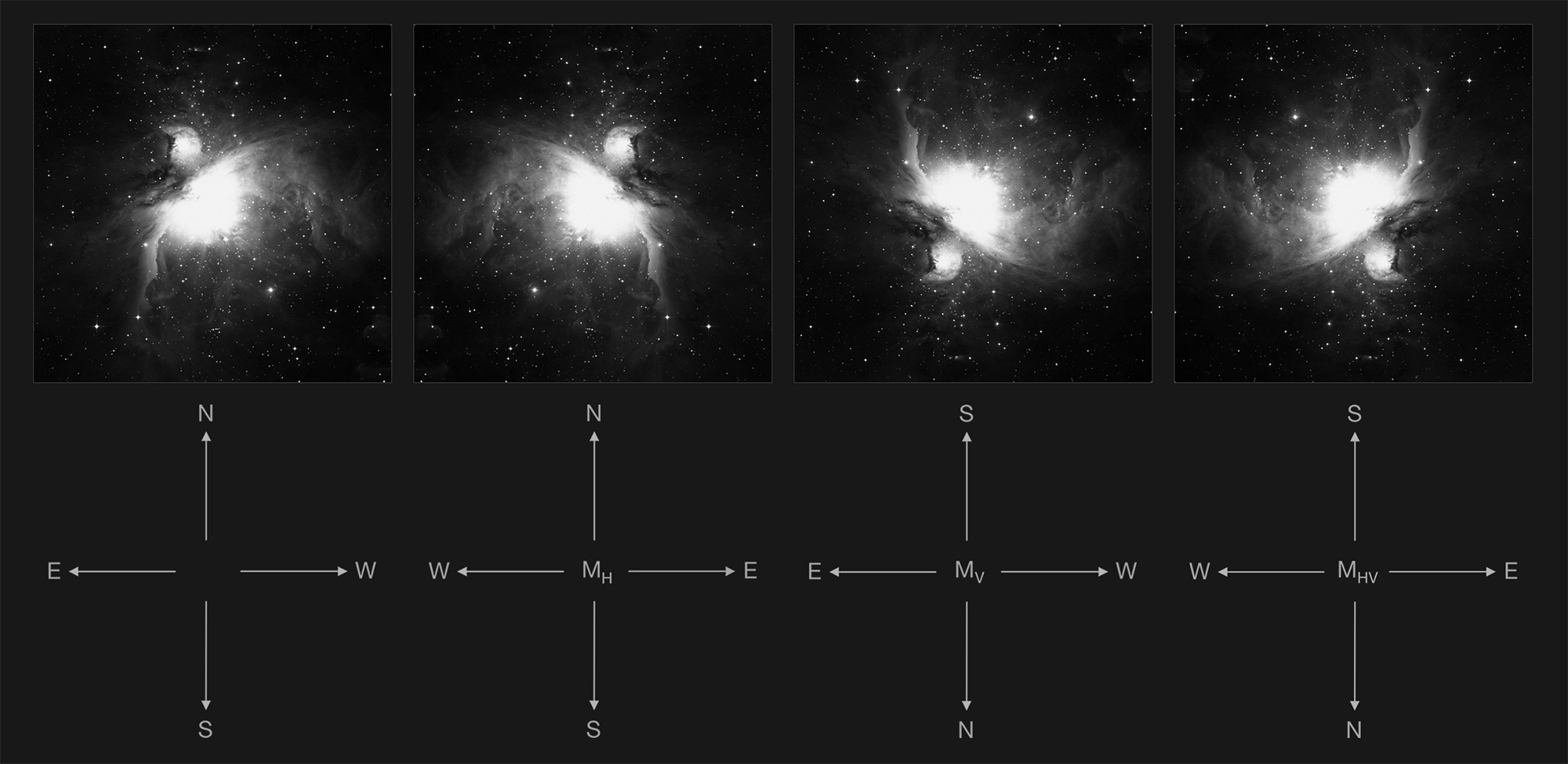Sometimes a change of perspective is all it takes to see the light.
- Dan Brown
The Clear Skies Observing Guides are available in 4 image orientations, to best match the view in the eyepiece.
- Unmirrored
- MH - mirrored horizontally
- MV - mirrored vertically
- MHV - mirrored horizontally & vertically (= rotated 180°)
A telescope with an odd number of mirrors in the optical path, for example the telescope's primary & secondary mirror + an accessory that mirrors such as a diagonal, will produce a mirrored view. An even number of mirrors, such as the two mirrors of a reflecting telescope's primary & secondary mirror, will cancel each other out and the resulting view will therefor be unmirrored.
Rotation
In addition to the transformation introduced by an odd number of mirrors in the optical path, the view can be rotated. This depends on the type of mount of the telescope (equatorially vs. azimuthally), any rotation of a diagonal, the postion of the observer's eye in relation to the eyepiece and the position in the sky at which the telescope is aimed.
Cardinal directions
North is towards the northern celestial pole, south is towards the southern celestial pole.
West is the direction towards which the sky appears to move and where objects set: “preceding”, in old school astro speak. East is where objects rise: “following”.
Unmirrored images

North up, west to the right.

This image orientation and/or the MHV orientation (mirrored horizontally & vertically = rotated 180°), is best suited for telescopes that produce an unmirrored view, such as newtonian reflectors, be it a dobsonian or an equatorially mounted newton.
Please note that an unmirrored view does not imply that the view cannot be rotated.
Mirrored horizontally - MH

North up, west to the left.

For example, a fork mounted SCT with a diagonal, equatorially aligned on a wedge in the northern hemisphere. Also, an SCT or refractor with a diagonal on a German Equatorial Mount (GEM), observing towards the south and either side of the meridian, with the observer on the northern side of the telescope.


Mirrored vertically - MV

North down, west to the right.

For example, an SCT on a GEM mount, with a diagonal, observing towards the north and either side of the meridian, with the observer on the southern side of the telescope. Also, a fork mounted SCT with a diagonal, equatorially aligned on a wedge in the southern hemisphere.


Mirrored horizontally & vertically (= rotated 180°) - MHV

North down, west to the left.

In essence, this is not a mirrored orientation but one rotated by 180 degrees.
This image orientation and/or the unmirrored orientation, is best suited for telescopes that produce an unmirrored (but often rotated) view, such as newtonian reflectors, be it a dobsonian or an equatorially mounted newton.
Recommendation
If you are unsure what image orientation best suits your needs, I recommend you start with an unmirrored CSOG edition. Observe an easy, bright object and compare the view of the object and the surrounding star field in your eyepiece to the image orientation in the observing guide. Determine if and how the view is mirrored and/or rotated, then determine what image orientation works best for you.
For my own observations, in the northern hemisphere, I use either my wedge mounted SCT or an SCT on a GEM. For the wedge mounted SCT I only use the MH guides. For the GEM mounted SCT I use the MH guides when observing towards the south and the MV guides when observing north of the zenith, as explained above.
Users of a dobsonian telescope - which is an azimuthally mounted newtonian reflector - will find that their view is unmirrored, but rotated. The amount of rotation is dependent on the position in the sky at which the telescope is aimed. Therefor, the unmirrored and the MHV (horizontally & vertically mirrored = rotated 180°) editions are best suited for this optical design.
What goes for a rotated view of a dobsonian, also goes for an azimuthally mounted SCT. With the one difference that the view in the SCT will be rotated and mirrored horizontally when using a diagonal.

